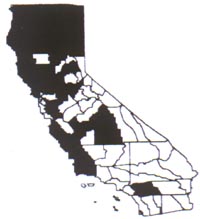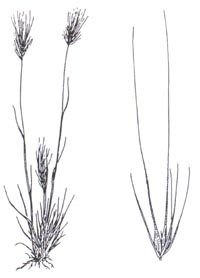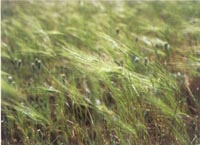|
Taeniatherum caput-medusae
|
|
|
|
Scientific name
|
Taeniatherum caput-medusae
|
|
Additional name information:
|
(L.) Nevski
|
|
Common name
|
medusahead
|
|
Synonymous scientific names
|
Elymus caput-medusae
|
|
Closely related California natives
|
Elymus arizonacus, E. canadensis
|
|
Closely related California non-natives:
|
2
|
|
Listed
|
CalEPPC List A-1,CDFA nl
|
|
By:
|
Oren Pollack,Tamara Kan
|
|
Distribution
|
|
|
HOW DO I RECOGNIZE IT?
Distinctive features:
|
Medusahead (Taeniatherum
caput-medusae) is a slender annual grass. The one- to three-inch awns are
straight and compressed when green, but, upon drying, the awns twist and spread
erratically in a manner reminiscent of the snake-covered head of the mythic
Medusa. Medusahead can often be recognized by its color, which stands out
against surrounding grasses. It matures from two to four weeks later than most
other annual grasses, displaying distinctive patches of green in an otherwise
brown grassland. After seed production, the dead medusahead plants bleach to
light gray or tan. Medusahead is sometimes confused with foxtail
(Alopecurus sp.) or with squirreltail (Elymus elymoides);
however, medusaheadÛªs spike head does not break apart as seeds
mature.
åÊ
|
|
Description:
|
| Poaceae. Stems: 8-24 in (2-6 dm) long, slender, decumbent to ascending. Leaves: sheath glabrous, appendages |
|
Inflorescence: 0.6-2 in (1.5-5 cm) excluding awns. Awns 1-3 in (2.5-7.5 cm), straight and compressed when green, twisting when dry. Spikelet: glumes 0.6-1.6 in (1.5-4 cm), fused at base, awn-like, stiff, generally glabrous; lemma narrowly lanceolate; awn 0.6-2 in (1.5-7.5 cm), flat, straight to curving outward (Hickman 1993).
|
|
WHERE WOULD I FIND IT?
|
As recently as 1950 medusahead was reported
from only six counties in northwestern California. It has since spread rapidly
throughout California, and currently is known to occur in over twenty counties
(Pollak pers. observation). It has been reported from almost every county in
northern California and in many areas of central California, extending as far
south as Riverside County. It also infests rangeland, grassland, and sagebrush
communities in Oregon, Washington, Idaho, Nevada, and Utah.
Medusahead invades grasslands, oak savannah, oak woodland, and
chaparral communities. It grows in a wide range of climatic conditions. Clay or
clay-loam soils with at least ten inches of rainfall annually are most
susceptible to invasion (Dahl and Tisdale 1975). However, medusahead has been
found on coarse-textured soils as well (Young 1992).
åÊ
|
|
WHERE DID IT COME FROM AND HOW IS IT SPREAD?
|
Medusahead is native to Spain, Portugal,
southern France, Morocco, and Algeria. It was introduced to the United States in
the late 1800s. The grass reproduces by seed, which is dispersed locally by wind
and water. The long-awned seeds cling to the coats of grazing animals, such as
sheep or cattle, and in this way are transported to more distant sites. Seeds
can also disperse by attaching to machinery, vehicles, and clothing.
åÊ
|
|
WHAT PROBLEMS DOES IT CAUSE?
|
Medusahead outcompetes native grasses and
forbs, and, once established, can reach densities of 1,000 to 2,000 plants per
square meter. After seed set, the silica-rich plants persist as a dense litter
layer that prevents germination and survival of native species, ties up
nutrients, and contributes to fire danger in summer. Because of its high silica
content, medusahead is unpalatable to livestock and native wildlife except early
in the growing season. The sharp awns can injure the eyes and mouths of
livestock.
åÊ
|
|
HOW DOES IT GROW AND REPRODUCE?
|
|
Medusahead is predominantly self-pollinating and reproduces by seed. Flowering usually occurs in May. An average of eight to fifteen seeds are produced per spike in late
|
(click on photos to view larger image)
|
spring or early summer. Seeds usually disperse by mid-summer. Seed dormancy
varies from a few weeks to over six months, depending on location. Germination
normally occurs with the first rains in fall, and the germination rate is high.
The seeds are well adapted to germinating and growing in the dense litter layer.
Under these conditions, seeds can germinate even if they are not touching the
soil. If they dry out, the primary root dies; but if they are moistened again, a
new adventitious root develops (Young et al. 1971).
In California medusahead seeds usually
germinate in October or November. The shoot system remains small, while the root
system develops throughout the cold winter months. Early germination and rapid
root growth consumes available water and nutrients, outcompeting slower-growing
native species. Medusahead continues to grow, extract soil moisture, and produce
seeds after most other annual grasses have turned brown.
|
|
HOW CAN I GET RID OF IT?
|
åÊ
|
|
Physical control:
|
Mechanical methods: Mowing alone, or in
combination with grazing, was found to be effective in reducing infestations.
Plowing or discing are also effective means for controlling medusahead (Hilken
and Miller 1980).
Prescribed burning: Several studies have shown that burning
stands of medusahead prior to seed dispersal is an effective control measure
(Furbush 1953, Hilken and Miller 1980, McKell et al. 1962, Murphy and Lusk 1961,
Pollak and Kan 1996). Burns should be scheduled for late spring, after seed set
but before seed heads have shattered (known as the ÛÏsoft doughÛ stage of seed
development). Seeds still on the plants are destroyed by the burn, while
dispersed seeds lying on or buried below the soil surface are protected from the
intense heat of the burn. With few seed reserves in the soil, medusahead
abundance can be dramatically reduced if the seed input for even one year is
eliminated.
This method takes advantage of the fact that medusahead matures
later than most of the surrounding vegetation, so most other species have
already dispersed their seeds and are dry enough to carry a burn. At the Jepson
Prairie Preserve in Solano County effective control burns were conducted in late
May and early June. Proper timing may vary depending on local conditions and
weather. Some studies have found medusahead to increase after burning, but most
of these studies conducted burns in August, presumably after seed
dispersal.
åÊ
|
|
Biological control:
|
Insect and fungi: No insect or fungal
control agents are known. However, some preliminary research has been done on
the effect of dry soil conditions on infestations of crown rot (Fusarium
culmoron), a soil-borne pathogen, on medusahead (Grey et al.
1995).
Grazing: Heavy grazing by sheep in early spring (when medusahead
is still palatable) can assist in controlling medusahead, but animals should be
removed before seed heads form to limit seed dispersal. Early spring grazing is
especially effective in areas where dried medusahead litter has been previously
burned or grazed. Fertilizing with nitrogen improves the palatability of
medusahead (Lusk et al. 1961). Properly timed grazing may reduce, but not
eliminate, medusahead infestations.
åÊ
|
|
Chemical control:
|
Small-scale infestations can be controlled
by chemical herbicides. Atrazine applied in fall at 2 lbs/acre, was effective in
controlling medusahead (Hilken and Miller, 1980). Check with a certified
herbicide applicator or the herbicide label for current registration
information.
åÊ
|



